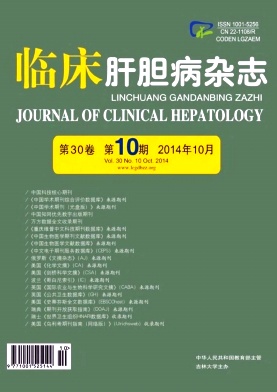|
[1]FERLAY J, SOERJOMATARAM I, DIKSHIT R, et al.Cancer incidence and mortality worldwide:sources, methods and major patterns in GLOBO-CAN 2012[J].Int J Cancer, 2014.[Epub ahead of print]
|
|
[2]KUMADA T, NAKANO S, TAKEDA I, et al.Clinical utility of Lens culinaris agglutinin-reactive alpha-fetoprotein in small hepatocellular carcinoma:special reference to imaging diagnosis[J].J Hepatol, 1999, 30 (1) :125-130.
|
|
[3]ODA K, IDO A, TAMAI T, et al.Highly sensitive lens culinaris agglutinin-reactive alpha-fetoprotein is useful for early detection of hepatocellular carcinoma in patients with chronic liver disease[J].Oncol Rep, 2011, 26 (5) :1227-1233.
|
|
[4]KUMADA T, TOYODA H, TADA T, et al.High-sensitivity Lens culinaris agglutinin-reactive alpha-fetoprotein assay predicts early detection of hepatocellular carcinoma[J].J Gastroenterol, 2014, 49 (3) :555-563.
|
|
[5]HSU HC, CHENG W, LAI PL.Cloning and expression of a developmentally regulated transcript MXR7 in hepatocellular carcinoma:biological significance and temporospatial distribution[J].Cancer Res, 1997, 57 (22) :5179-5184.
|
|
[6]NAKATSURA T, YOSHITAKE Y, SENJU S, et al.Glypican-3, overexpressed specifically in human hepatocellular carcinoma, is a novel tumor marker[J].Biochem Biophys Res Commun, 2003, 306 (1) :16-25.
|
|
[7]HIPPO Y, WATANABE K, WATANABE A, et al.Identification of soluble NH2-terminal fragment of glypican-3 as a serological marker for early-stage hepatocellular carcinoma[J].Cancer Res, 2004, 64 (7) :2418-2423.
|
|
[8]DI TOMMASO L, FRANCHI G, PARK YN, et al.Diagnostic value of HSP70, glypican 3, and glutamine synthetase in hepatocellular nodules in cirrhosis[J].Hepatology, 2007, 45 (3) :725-734.
|
|
[9]LIBBRECHT L, SEVERI T, CASSIMAN D, et al.Glypican-3expression distinguishes small hepatocellular carcinomas from cirrhosis, dysplastic nodules, and focal nodular hyperplasia-like nodules[J].Am J Surg Pathol, 2006, 30 (11) :1405-1411.
|
|
[10]FILMUS J, CAPURRO M.Glypican-3:a marker and a therapeutic target in hepatocellular carcinoma[J].FEBS J, 2013, 280 (10) :2471-2476.
|
|
[11]LUO WM, CHEN L, CAO YL, et al.Diagnostic significance of combined application of serum GP73 and AFP-L3 in patients with PHC[J].J Clin Exp Med, 2013, 12 (13) :1005-1009. (in Chinese) 罗文明, 陈琳, 曹亚丽, 等.血清GP73及AFP-L3检测在原发性肝癌诊断中的意义[J].临床和实验医学杂志, 2013, 12 (13) :1005-1009.
|
|
[12]KLADNEY RD, CUI X, BULLA GA, et al.Expression of GP73, a resident Golgi membrane protein, in viral and nonviral liver disease[J].Hepatology, 2002, 35 (6) :1431-1440.
|
|
[13]HOU SC, XIAO MB, NI RZ, et al.Serum GP73 is complementary to AFP and GGT-II for the diagnosis of hepatocellular carcinoma[J].Oncol Lett, 2013, 6 (4) :1152-1158.
|
|
[14]BA MC, LONG H, TANG YQ, et al.GP73 expression and its significance in the diagnosis of hepatocellular carcinoma:a review[J].Int J Clin Exp Pathol, 2012, 5 (9) :874-881.
|
|
[15]GU Y, CHEN W, ZHAO Y, et al.Quantitative analysis of elevated serum Golgi protein-73 expression in patients with liver diseases[J].Ann Clin Biochem, 2009, 46 (Pt 1) :38-43.
|
|
[16]HU JS, WU DW, LIANG S, et al.GP73, a resident Golgi glycoprotein, is sensibility and specificity for hepatocellular carcinoma of diagnosis in a hepatitis B-endemic Asian population[J].Med Oncol, 2010, 27 (2) :339-345.
|
|
[17]XU YY, LIU YP.Correlation between midkine and malignant tumors[J].J Med Mol Biol, 2007, 4 (4) :347-349. (in Chinese) 徐莹莹, 刘云鹏.Midkine和恶性肿瘤[J].医学分子生物学杂志, 2007, 4 (4) :347-349.
|
|
[18]HUNG YJ, LIN ZH, CHENG TI, et al.Serum midkine as a prognostic biomarker for patients with hepatocellular carcinoma[J].Am J Clin Pathol, 2011, 136 (4) :594-603.
|
|
[19]CUI R, HE J, ZHANG F, et al.Diagnostic value of protein induced by vitamin K absence (PIVKAII) and hepatoma-specific band of serum gamma-glutamyl transferase (GGTII) as hepatocellular carcinoma markers complementary to alpha-fetoprotein[J].Br J Cancer, 2003, 88 (12) :1878-1882.
|
|
[20]INAGAKI Y, TANG W, XU H, et al.Des-gamma-carboxyprothrombin:clinical effectiveness and biochemical importance[J].Biosci Trends, 2008, 2 (2) :53-60.
|
|
[21]GAO JJ, INAGAKI Y, XUE X, et al.c-Met:a potential therapeutic target for hepatocellular carcinoma[J].Drug Discov Ther, 2011, 5 (1) :2-11.
|
|
[22]OH BK, KIM H, PARK YN, et al.High telomerase activity and long telomeres in advanced hepatocellular carcinomas with poor prognosis[J].Lab Invest, 2008, 88 (2) :144-152.
|
|
[23]MIURA N, OSAKI Y, NAGASHIMA M, et al.A novel biomarker TERTmRNA is applicable for early detection of hepatoma[J].BMC Gastroenterol, 2010, 10:46.
|
|
[24]LECHEL A, MANNS MP, RUDOLPH KL.Telomeres and telomerase:new targets for the treatment of liver cirrhosis and hepatocellular carcinoma[J].J Hepatol, 2004, 41 (3) :491-497.
|
|
[25]KONG SY, PARK JW, KIM JO, et al.Alpha-fetoprotein and human telomerase reverse transcriptase mRNA levels in peripheral blood of patients with hepatocellular carcinoma[J].J Cancer Res Clin Oncol, 2009, 135 (8) :1091-1098.
|
|
[26]FRIEDMAN RC, FARH KK, BURGE CB, et al.Most mammalian mRNAs are conserved targets of microRNAs[J].Genome Res, 2009, 19 (1) :92-105.
|
|
[27]LI L, GUO Z, WANG J, et al.Serum miR-18a:a potential marker for hepatitis B virus-related hepatocellular carcinoma screening[J].Dig Dis Sci, 2012, 57 (11) :2910-2916.
|
|
[28]YAMAMOTO Y, KOSAKA N, TANAKA M, et al.MicroRNA-500 as a potential diagnostic marker for hepatocellular carcinoma[J].Biomarkers, 2009, 14 (7) :529-538.
|
|
[29]QI P, CHENG SQ, WANG H, et al.Serum microRNAs as biomarkers for hepatocellular carcinoma in Chinese patients with chronic hepatitis B virus infection[J].PLoS One, 2011, 6 (12) :e28486.
|
|
[30]SUN J, LU H, WANG X, et al.MicroRNAs in hepatocellular carcinoma:regulation, function, and clinical implications[J].The Scientific World J, 2013, 2013:924206.
|
|
[31]MA LX, WEI XH, ZHANG J.Recent perspectives on the role of microRNAs of the miR-15 family in liver disease[J].J Clin Hepatol, 2013, 29 (2) :158-160. (in Chinese) 马丽霞, 韦新焕, 张晶.miR-15家族在肝脏疾病中的作用[J].临床肝胆病杂志, 2013, 29 (2) :158-160.
|
|
[32]HE Y, MENG XM, HUANG C, et al.Long noncoding RNAs:Novel insights into hepatocelluar carcinoma[J].Cancer Lett, 2014, 344 (1) :20-27.
|
|
[33]XIE H, MA H, ZHOU D.Plasma HULC as a promising novel biomarker for the detection of hepatocellular carcinoma[J].Biomed Res Int, 2013, 2013:136106.
|
|
[34]LAI MC, YANG Z, ZHOU L, et al.Long non-coding RNA MALAT-1 overexpression predicts tumor recurrence of hepatocellular carcinoma after liver transplantation[J].Med Oncol, 2012, 29 (3) :1810-1816.
|







 DownLoad:
DownLoad: